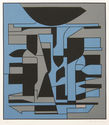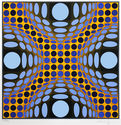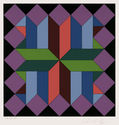
19th, 20th & 21st Century Fine Prints
707-546-7352 · fax 707-546-7924 · web: www.annexgalleries.com · email: artannex@aol.com
Victor Vasarely Biography
Victor Vasarely
Hungarian French
1906–1997
Biography
Victor Vasarely (Vásárhelyi Győző) (1906 -1997) was a French Hungarian-born artist often acclaimed as the father of Op-art. Working as a graphic artist in the 1930s he created what is considered the first Op-art piece Zebra, consisting of curving black and white stripes, indicating the direction his work would take. Over the next two decades, Vasarely developed his style of geometric abstract art and gained international renown.
Born in Pecs, Hungary on April 9, 1906 Vasarely was raised in Budapest, and took up medical studies ay Budapest University in 1925. Two years later, he abandoned medicine to study painting at Polini-Volkmann Academy, and later at the Mülheny, where he expanded his studies in graphic art. He married fellow student Claire Spinner in 1930 and they had two sons; around this time they left Hungary and moved to Paris, where he worked as a creative consultant in advertising.
At the end of the Second World War, he opened an atelier in Arcueil, and began to focus on his more geometric paintings and prints, beginning to refine his spatial problem-solving on both flat surfaces and in three dimensional sculpting. He would later evolve his style to include optical illusion based on the research of constructivist and Bauhaus pioneers. Mathematical elements played throughout his pieces as well as his techniques, and he was eventually dubbed the inventor and creator of Op-Art.
Vasarely received the Guggenheim Prize, French Chevalier de L’Ordre de la Legion d’Honneur, Art Critics Prize (Brussels), and the Gold Medal at the Milan Trienalle. His works are found at the Vasarely Museums in Hungary and France, as well as various collections throughout the world. He died in Paris on March 15, 1997.




